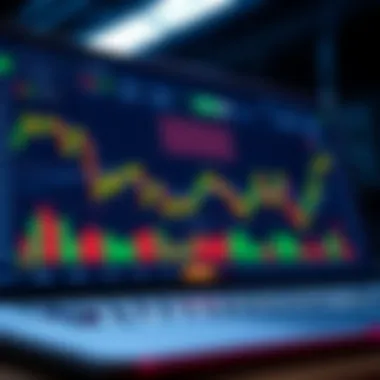Discovering Top Derivatives Trading Platforms Today


Intro
In today's fast-paced financial landscape, derivatives trading continues to attract a mixture of seasoned investors and budding traders. Understanding the best platforms for engaging with derivatives can be a daunting task, fraught with nuances and essential factors worth considering. This article sets out to unravel the complexities of derivatives trading platforms, shedding light on their unique features, security aspects, and performance metrics. Whether you're dipping your toes into the investment waters or looking to optimize your existing strategies, this exploration promises to be of utmost relevance.
The importance of choosing an appropriate platform can't be overstated. A platform’s user experience, tools available for analysis, and security measures can significantly influence trading outcomes. This detailed examination seeks to arm readers with the knowledge they need to traverse this multifaceted terrain and make informed decisions.
Key Features of Derivatives Trading Platforms
When diving into the world of derivatives, it's crucial to comprehend the core features of successful trading platforms. Consider the following key aspects:
- User Interface: A seamless, intuitive interface can make a world of difference. Traders often perform multiple actions at once – entering trades, analyzing charts, and monitoring market movements. Therefore, an easily navigable platform can enhance performance significantly.
- Asset Variety: The range of derivatives offered is another important feature. Some platforms focus on specific asset classes like futures, options, or swaps, while others provide access to a diversified array of derivatives.
- Research and Tools: Advanced charting tools and market analysis are pivotal for informed trading. Platforms offering in-depth analysis often empower traders to spot trends and make decisions quicker than those without such resources.
- Security Protocols: With high stakes involved, security is of utmost importance. Look for platforms that have robust encryption methods and regulatory compliance.
- Customer Support: Quick, effective customer support can facilitate resolving issues that may arise, contributing to a smoother trading experience.
Advantages of Using Derivatives Trading Platforms
The benefits of leveraging derivatives trading platforms are extensive. Here are some highlights:
- Leverage Opportunities: Traders can control larger positions with smaller amounts of capital, potentially escalating both profits and risks.
- Flexible Strategies: Derivatives provide opportunities for hedging against market fluctuations, allowing for tailored risk management strategies.
- Access to Markets: Many platforms offer access to international markets, enabling traders to diversify their portfolios effectively.
- 24/7 Trading: Many derivatives products trade around the clock, allowing investors to capitalize on global market movements at their convenience.
By thoroughly assessing these features and advantages, investors can find a platform that aligns with their trading goals and risk tolerance. The next section will delve into specific platforms, dissecting their offerings and drawing comparisons to aid traders in identifying the cream of the crop.
Understanding Derivatives Trading
In the intricate world of finance, derivatives trading serves as a bridge connecting various investments and strategies. It’s not just a side note in market operations; rather, it plays a pivotal role in enhancing liquidity, diversifying portfolios, and providing avenues for risk management. As we dive into this discussion, it’s essential to unpack the essence of derivatives and their critical facets.
Defining Derivatives
Derivatives are financial contracts whose value is derived from the performance of an underlying asset, index, or rate. This can include stocks, bonds, commodities, or even market indices. The beauty of derivatives lies in their versatility; they can be used for hedging against risk or for speculative purposes. Investors leverage derivatives to gain exposure to a broad range of market movements without needing to invest directly in the underlying asset. As a trader, understanding these instruments can unlock a new level of strategic financial management.
Types of Derivatives
Futures
Futures are agreements to buy or sell an asset at a predetermined price at a specified time in the future. One of the key characteristics of futures is that they are standardized contracts traded on exchanges, which simplifies the trading process. This standardization allows traders to manage their exposure effectively while providing liquidity.
The unique edge of futures contracts lies in their use of leverage, enabling investors to control larger positions with a fraction of the capital. However, while leverage can magnify gains, it also elevates the risk of significant losses, making it critical for traders to fully understand their position.
Options
Options give the buyer the right, but not the obligation, to purchase or sell an asset at a set price before a certain date. The key appeal of options is flexibility; they can be used to hedge risks, speculate on price movements, or enhance portfolio income through writing strategies.
A notable feature of options is the limited risk for buyers, as their maximum loss is limited to the premium paid for the option. On the flip side, sellers face potentially unlimited risk, underlining the need for careful risk assessment and strategy development.
Swaps
Swaps are agreements to exchange cash flows between two parties. Common types include interest rate swaps and currency swaps. In essence, they allow parties to manage their exposure to fluctuations in interest rates or currencies. One of the defining characteristics of swaps is their customization; unlike futures and options, swaps are often privately negotiated and can be tailored to meet the specific needs of the parties involved.
However, while highly flexible, swaps lack the liquidity of exchange-traded products, which can make them less accessible for individual investors, thereby posing a challenge in terms of execution and pricing transparency.
Contracts for Difference
Contracts for Difference (CFDs) allow traders to speculate on price movements without owning the underlying asset. A prominent characteristic of CFDs is their use of leverage, similar to futures, allowing traders to amplify their exposure to price changes with a minimum upfront investment.
The advantage of CFDs lies in their flexibility and ease of use; they can be traded on various asset classes without the complexities of traditional trading. However, it’s crucial to recognize the potential for losses to also be amplified due to the leverage.
Significance of Derivatives in Financial Markets
Derivatives play an indispensable role in modern financial markets. They not only facilitate price discovery but also enhance market efficiency by providing critical information on future price movements. Consider these functions:
- Risk Management: Entities can hedge risks associated with price volatility, allowing for more stable financial planning.
- Speculative Opportunities: Traders can capitalize on short-term price movements without a significant capital outlay.
- Market Liquidity: Derivatives attract investors’ interest, increasing the overall liquidity in markets.
In sum, derivatives are not merely financial tools; they are essential components that serve to enrich the investing experience while providing options for managing risks effectively. Understanding these elements is crucial for any investor looking to navigate the complex landscape of derivatives trading.
Criteria for Selecting a Derivatives Trading Platform
When venturing into the landscape of derivatives trading, the platform you choose can make or break your trading experience. Understanding the criteria that differentiate these platforms is crucial. Such criteria not only affect how you trade but also influence your overall satisfaction and financial outcomes. In this section, let's dive into essential elements that will guide your decision.
Regulatory Compliance


One of the first things to consider is regulatory compliance. Every trader should be aware that not every broker plays by the same rules. A platform that adheres to regulations set by financial authorities like the Securities and Exchange Commission (SEC) or the Commodity Futures Trading Commission (CFTC) ensures a level of safety and integrity. This compliance acts like a safety net, giving you peace of mind while trading. Without it, you might as well be playing poker without knowing the hands.
It is also beneficial to choose platforms under the purview of reputed jurisdictions, like the Financial Conduct Authority (FCA) in the UK. This compliance indicates the platform has met stringent operational standards, protecting your funds more effectively. Overall, regulatory compliance is akin to a badge of honor, reflecting the platform’s legitimacy and reliability.
User Experience
User experience is another pivotal aspect to take seriously. A clunky, unintuitive interface can turn even the best trading strategies into a frustrating experience. Platforms with a clean layout, streamlined navigation, and responsive design often allow traders to make split-second decisions without hurdles. You want a platform where you can navigate like butter on a hot skillet.
Look for customizable dashboards that cater to your trading style. Some platforms even offer demo accounts so traders can familiarize themselves with the interface, which is helpful, especially for novice traders. Ultimately, a pleasant user experience enhances your trading journey, making it smooth and more productive.
Trading Fees and Cost Structure
Understanding the trading fees and cost structure is crucial, as these can chip away at your profits faster than you might think. Here, we'll break down the major components of trading costs.
Commission Fees
Commission fees are the charges you pay to the broker each time you execute a trade. They vary widely across platforms, impacting your bottom line. A lower commission can benefit frequent traders, turning what could be a loss into profit. If a platform offers zero-commission trades, it might sound too good to be true, but it can provide significant savings. They often offset these costs through spreads or other fees, so weigh these factors carefully.
Transparent commission policies are a sign of a trustworthy broker. The last thing you want is hidden fees lurking in the shadows.
Spread Costs
Spread costs are another critical consideration. The spread is the difference between the buying and selling price of an asset. A tighter spread means lower costs for you as a trader. This can be particularly essential in volatile markets where price changes can happen in a blink. If a platform offers lower spreads, it can make a world of difference for day traders and scalpers looking to capitalize on minute price movements.
However, always bear in mind that some platforms may advertise low spreads to attract customers but lack robustness in other areas. Evaluate the entire cost structure, not just the spread.
Withdrawal Fees
Next come withdrawal fees, which can sting if you're not cautious. These are charges you incur when withdrawing your earnings. Some platforms have generous policies, allowing you to withdraw funds free of charge once per month, while others may charge a fee each time. Always do your homework on a platform’s withdrawal terms—sometimes they can be more restrictive than you expect.
Understanding these fees helps to build a clear picture of the overall cost of trading. The more informed you are, the better your strategy can be, ensuring that surprise charges don’t nip your profits in the bud.
Available Trading Instruments
Access to a range of available trading instruments is fundamental. Different platforms offer varied options, including stocks, commodities, and currencies. A wider selection allows you to diversify your portfolio, adding a layer of risk management. Specializing in certain areas can make a platform more attractive. For instance, if you have a penchant for trading options, choose a platform that excels in this area.
Customer Support Quality
Lastly, never underestimate the customer support quality. A responsive support team can be the difference between resolving an urgent trading issue or being left high and dry. Whether through live chat, email, or phone, it's crucial to have access to knowledgeable staff whenever required.
Platforms offering robust support during peak trading hours or with multi-lingual staff not only assist in solving problems but also enhance the overall experience. In a market where timing is everything, a swift resolution can save you both time and money.
In short, navigating the world of derivatives trading platforms requires careful consideration of these criteria. From regulatory compliance to support quality, each factor influences your experience and can ultimately determine your success.
Review of Leading Derivatives Trading Platforms
Examining the leading derivatives trading platforms is crucial for investors who want to maximize their trading experience and minimize risks. Understanding the features, usability, and reliability of these platforms can make a significant difference in trading outcomes. Investors have an array of choices available to them, but not all platforms offer the same level of performance, user satisfaction, or security. This section will scrutinize some of the top options available, providing insights into their characteristics, pros and cons, and overall utility for different trading strategies.
Platform One: Overview
Features
Platform One comes packed with a plethora of features designed to cater to both novices and seasoned traders. A standout characteristic is its comprehensive research tools, which empower users to conduct thorough market analyses. The advanced charting capabilities allow for real-time monitoring of market fluctuations, making it a favorable option for traders who emphasize timely decisions. One unique aspect is its integration of machine learning algorithms that provide predictive analytics. While this is a powerful tool, the reliability of software can sometimes lead to overconfidence in predictive accuracy, introducing a potential risk to users.
User Interface
The user interface of Platform One is sleek and intuitive. Newbies find it easy to navigate, while experienced traders can customize their dashboard for maximum efficiency. This adaptability is essential for maintaining focus during volatile trading conditions. A distinctive feature is its drag-and-drop functionality, allowing traders to arrange widgets as per their preference, enhancing the overall user experience. However, users have reported occasional lag during high-traffic periods, which might disrupt trading decisions.
Pros and Cons
Pros:
- Comprehensive research tools that enhance decision making
- User-friendly interface that caters to all skill levels
- Advanced security protocols that instill confidence in users
Cons:
- Occasional software lag during peak usage
- Some predictive tools may lead to overestimation of trading success


Platform Two: Overview
Features
Platform Two is celebrated for its low trading fees combined with a rich feature set. A defining advantage is its unique social trading element, which lets users follow and copy the trades of successful investors. This is particularly attractive for those who are just dipping their toes in derivatives trading. However, newcomers should tread carefully, as blindly following others can lead to losses if the copied strategies aren’t well thought out. The platform also offers educational resources that are invaluable for honing trading skills.
User Interface
The user interface of Platform Two leans towards being minimalistic, focusing on essential tools rather than clutter. This could be viewed as beneficial since it promotes clarity and easy access to vital information. A unique aspect is the customizable alerts feature, notifying users of significant market changes. However, some traders have mentioned that the lack of extensive customization options in widgets can be limiting for users who prefer a more detailed dashboard.
Pros and Cons
Pros:
- Low trading fees that make it accessible for casual investors
- Social trading features that enhance engagement
- Strong educational resources for traders of various levels
Cons:
- Minimalistic design may not satisfy those desiring more detailed features
- Copy trading can lead to uninformed decisions if not well managed
Platform Three: Overview
Features
Platform Three’s hallmark is its robust analytical tools which are backed by sophisticated data analysis. This platform is particularly appealing to analytical traders who rely heavily on quantitative data to inform their strategies. One standout feature is its back-testing capability, allowing traders to evaluate their strategies using historical data, which can be a game-changer in decision-making. Of course, the complexity of this feature may overwhelm less experienced users, requiring them to engage with tutorials to fully harness its potential.
User Interface
When it comes to user interface, Platform Three strikes a balance between sophistication and usability. It incorporates various modules that can be used independently or together depending on user preference. A particularly beneficial feature is its customizable layout, allowing advanced users to set up an environment that best suits their style. However, less experienced traders may find the initial learning curve steep, which can deter them from using some of the more advanced tools available.
Pros and Cons
Pros:
- Sophisticated analytical tools that improve strategy formulation
- Customizable layouts catering to advanced traders
- Back-testing capabilities providing historical insights
Cons:
- Steep learning curve for beginners can be discouraging
- Complexity of tools might not suit casual or low-frequency traders
Through evaluating these platforms, it becomes apparent that each brings something unique to the table. Understanding these nuances is paramount for traders looking to find a platform that aligns with their trading style and risk tolerance.
Evaluating Emerging Platforms in Derivatives Trading
The derivatives trading landscape is continuously evolving, and this dynamism presents both opportunities and challenges for investors. When evaluating emerging platforms, it becomes critical to identify those that not only meet the current demands but also possess the potential for future growth. Emerging platforms often leverage cutting-edge technologies and offer innovative features that can cater to a diverse trading audience.
Being a savvy investor involves understanding which services stand out and deliver on their promises. Key elements like user experience, costs, and security measures play a significant role. A platform’s ability to offer competitive pricing, coupled with a user-friendly interface, can be the difference between success and stagnation in the world of derivatives.
Innovations in User Experience
User experience is more than just a buzzword; it’s a vital aspect that can influence a trader's performance. Emerging platforms are focusing on simplifying navigation and customizing user interfaces. Features such as real-time data feeds, interactive charts, and mobile accessibility are becoming standard, allowing traders to make swift decisions at their convenience.
For instance, platforms like Binance or BitMEX are often praised for their intuitive designs and robust tools. Users can enjoy unique functionalities, such as customizable dashboards and integrated educational resources, which can enhance the overall trading experience. These innovations can often mean everything, especially for newer traders who may find even basic functions confusing.
Cost-Effective Solutions
Emerging platforms frequently tend to attract users through cost-efficiency. Many aim to lure traders with low to zero commission fees, transparent pricing models, and minimal spreads. In a time when every penny counts, especially for those with smaller portfolios, understanding fee structures can save investors a lot of headaches down the line.
In fact, platforms like Robinhood have taken this approach to the next level by removing commissions altogether, thereby democratizing access to trading. However, traders must tread carefully. Low fees can sometimes mean compromises in service quality or security, so it's essential to weigh the pros and cons carefully. Investing a bit more into a reliable, reputable platform could be worth the peace of mind.
Security Measures Adopted
Security is a paramount concern when engaging in derivatives trading. Emerging platforms must prioritize the implementation of robust cybersecurity measures to gain and maintain the trust of their users. Many platforms utilize multi-factor authentication, encryption protocols, and insurance against breaches to protect user data and funds.
For instance, platforms such as eToro are known for their commitment to security, featuring stringent identity verification processes and regular audits. However, not all emerging platforms meet similar standards. Therefore, it is incumbent on users to conduct thorough research and ensure any platform they consider has taken the necessary steps to safeguard their investments.
"In the world of derivatives, a single oversight can cost you dearly. Hence, selecting platforms with strong security protocols is non-negotiable."


In summary, the evaluation of emerging derivatives trading platforms involves a meticulous examination of innovation in user experience, cost-effectiveness, and security measures. These aspects are fundamental in navigating through a landscape that is both competitive and complex, equipping traders with the tools necessary for successful investing.
Risk Management in Derivatives Trading
Risk management stands as a pillar in derivatives trading, holding the keys to a disciplined and informed investment approach. In a field where complexities abound and potential losses can escalate quickly, understanding risk management can mean the difference between profit and significant setbacks. Each trader, from novice to seasoned, must learn the ropes of managing their risk to safeguard their portfolios.
Understanding Leverage
Leverage, in the derivatives market, allows traders to control larger positions with a smaller amount of capital. It functions like a double-edged sword. On one hand, it can amplify profits; on the other hand, it increases potential losses. This dynamic nature means that the stakes can be quite high. Effective use of leverage requires not only knowledge but an acute sense of risk tolerance. The thrilling opportunity that leverage presents is often tempered by the understanding that it also enhances the risk exposure significantly.
Traders need to tread lightly and develop a keen insight into how much leverage is optimal for their trading style and strategy. Utilizing tools such as a leverage calculator can help visualize the impact of leverage on both potential profits and losses, assisting in making informed decisions.
Protective Strategies
In the ever-shifting landscape of derivatives trading, implementing sound protective strategies becomes essential to minimize potential losses. Two well-known strategies—hedging and stop-loss orders—serve to protect traders against unforeseen market movements.
Hedging
Hedging is like taking out an insurance policy for your investments. When you hedge, you enter into a position that offsets potential losses in another investment. This strategy is highly favored due to its effectiveness in mitigating risks associated with market volatility. For instance, if you’re holding a futures contract that you fear might lose value, you can take an opposing position in a related derivative to cushion against market downturns.
One of the key characteristics that makes hedging a popular choice is its ability to provide a safety net without having to liquidate your initial investment. However, hedging isn’t without its drawbacks. It can involve transactions costs that may erode potential gains, and if not managed properly, it could lead to complex positions that might complicate your trading strategy.
Stop-Loss Orders
Stop-loss orders are another fundamental risk management tool that traders employ. This order allows traders to set a specific price at which their position will automatically be sold to prevent further losses. It acts as a shield, preventing emotional decision-making and enforcing discipline in trading practices. Traders often find comfort in knowing that their risk exposure is controlled to a certain extent, allowing them to maintain focus on their broader strategy.
The unique feature of stop-loss orders is their automatic execution, which provides a safety net without the need for continuous monitoring. This can be particularly advantageous in volatile market situations where prices can change drastically in a matter of moments. However, one must take care that setting a stop-loss too close to the entry price might result in a premature exit from a position, which may not reflect the overall market trend.
"In a fast-paced market, those who manage risks effectively can turn challenges into opportunities."
By understanding and applying these principles, investors can create a more stable and sustainable trading experience.
The Future of Derivatives Trading Platforms
The landscape of derivatives trading platforms is swiftly evolving, influenced by technological advancements and shifting regulatory frameworks. As we compete our discussion about derivatives trading, it's essential to explore the future trends that are shaping these platforms. This examination not only highlights upcoming innovations but also examines their implications for traders and investors alike.
Trends in Technology
Technology is at the forefront of transforming derivatives trading. With artificial intelligence and machine learning gaining traction, trading platforms are becoming more intuitive. Algorithms are now able to analyze vast amounts of market data in a fraction of a second, allowing for faster decision-making and optimized trading strategies. Platforms like IIROC or CME Group are integrating sophisticated tools that can offer real-time analytics and predictive modeling.
Another notable trend is the growth of blockchain technology, which promises to enhance the security and transparency of derivatives trading. Transactions recorded on a blockchain can be audited in real-time, reducing the potential for fraud and manipulation. This level of transparency might build greater trust among participants, encouraging more investors to engage with derivatives trading.
Moreover, mobile trading has become a significant player, offering users the flexibility to make trades from anywhere. High-quality mobile versions of platforms are crucial for attracting a younger demographic of traders. Apps equipped with user-friendly interfaces and comprehensive functionalities are helping to democratize access to derivatives engaging even those who might be new to trading.
Impact of Regulation
Regulation is the double-edged sword for derivatives trading platforms. On one hand, stronger regulations are crucial for protecting investors and ensuring market integrity. Regulatory bodies like the Securities and Exchange Commission (SEC) continuously adapt their frameworks to keep pace with rapid technological changes. As such, platforms that transparently comply with regulations not only earn the trust of users but also mitigate risks of legal challenges down the road.
On the other hand, excessive regulation can stifle innovation. Startups and smaller players might find it challenging to bear the compliance costs. This creates barriers to entry that predominantly favor established firms. Thus, a balanced approach from regulators is necessary. Finding equilibrium will help maintain market integrity without hindering the evolution of platform technologies.
The future of derivatives trading hinges on an ongoing dialogue between innovation and regulation, ensuring that both progress and protection are achieved.
In summary, the future of derivatives trading platforms will likely be shaped by technological advancements that offer enhanced user experiences and regulatory frameworks that encourage safe trading practices. Each of these factors is necessary to ensure a robust and dynamic marketplace, ultimately benefiting investors and traders.
End
In this final section, we wrap up the intricate journey through the world of derivatives trading platforms. The content shared earlier sheds light on not only the features and innovations of various platforms but also stresses the necessary considerations investors must take into account before diving in. The key is understanding that the right platform is not merely a matter of preference, but hinges on a combination of factors including usability, costs, security, and the range of instruments available for trading.
The discussion on selected platforms illustrates how each has carved its niche in the market, distinguished by user experience and the degrees of risk management they advocate. For traders, both seasoned and newcomers alike, it’s vital to systematically assess these factors. By doing this, investors will find themselves not just choosing a platform, but aligning with one that complements their trading style and goals.
“Choosing a trading platform is much like selecting a gear for a trek; you need the right tools to navigate the landscape ahead.”
Key Takeaways
- Regulatory Compliance is Critical: Always opt for platforms that prioritize compliance with regulatory standards. This not only enhances security but also builds trust.
- Cost Structure Varies: Understand trading fees, commissions, and other costs as they can significantly impact profitability. Some platforms present lower commissions but add higher spreads that can erode gains.
- User Experience Matters: Platforms with intuitive designs can ease learning curves, especially for newbies, while those with complex interfaces may deter engagement.
- Customer Support is Essential: Quality customer support can distinguish a good platform from a great one, particularly during times of market stress or technical difficulties.
- Diversification of Instruments: Check the variety of trading instruments available. Some platforms restrict asset classes which might limit your trading strategy.
Final Thoughts on Choosing the Right Platform
Deciding on a derivatives trading platform demands a thorough understanding of one’s own trading needs. Some traders thrive in high-volatility environments and require platforms that facilitate rapid trading, while others may opt for a slow-and-steady approach that enjoys robust analytical tools. The key is to visualize what success looks like for you and then research platforms that have a proven track record in facilitating that journey.
In the fast-evolving landscape of derivatives trading, rest assured that constant advancements are poised to enhance user experience, pricing structures, and feature sets. Stay informed and don’t hesitate to seek resources such as Investopedia or Reddit’s r/Forex for the latest discussions and insights.
Ultimately, the right choice can be a powerful ally in navigating the complexities of derivatives trading, yielding not just knowledge but also potentially lucrative outcomes.















